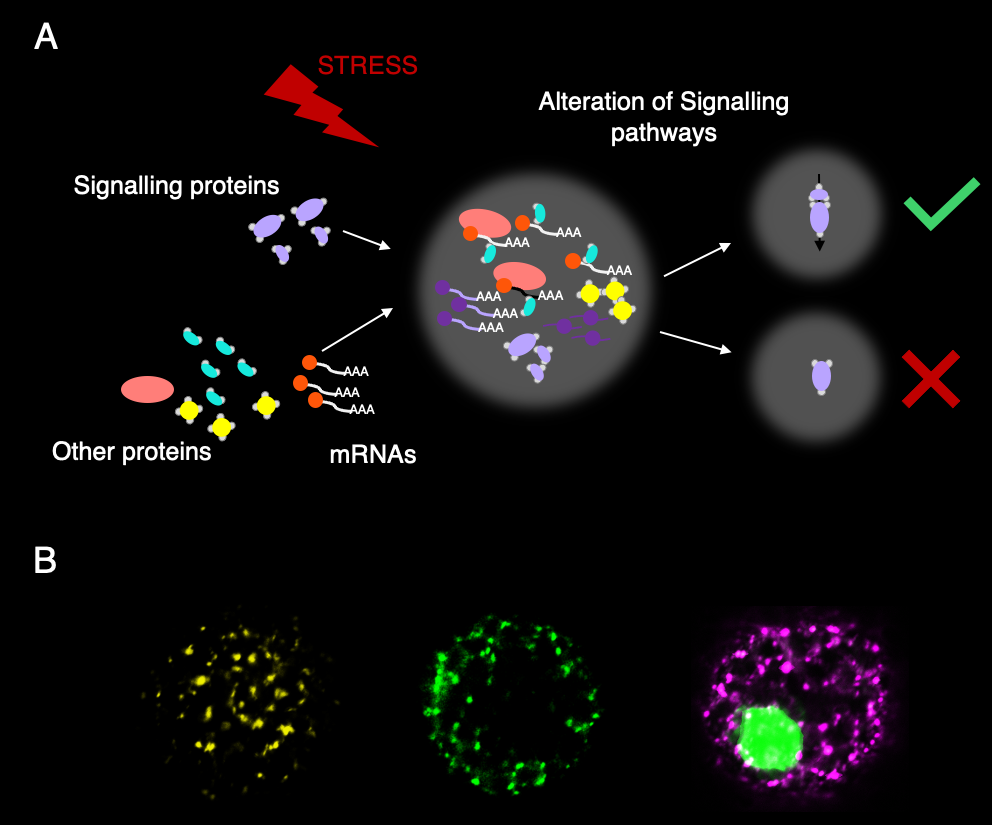Plants are continuously exposed to a wide range of environmental cues which have a major impact on their development and productivity, thus causing serious agricultural yield losses. As a consequence, they have developed a complete set of cellular mechanisms to adapt and survive to ever-changing and stressful environmental conditions. A powerful and fast cellular response conserved among eukaryotes is the assembly of stress granules (SGs). Stress Granules (SGs) are a type of biomolecular condensates formed through liquid-liquid phase separation (LLPS) and composed of RNAs and proteins that arise in the cytoplasm in response to both environmental and internal signals. The formation of SGs minimizes stress-related damage and promotes cell survival, although the molecular mechanisms underlying pro-survival effects of SGs remain to be established. In contrast to the prominence of research on stress granule in animal and yeast models, in plants, SGs have only received limited attention. This is surprising, considering the importance of these molecular condensates for the cell fate.
Our goal is to establish a profound conceptual and experimental framework allowing us to understand the molecular pathways underlying formation of SGs in plants, which will be used as a basis to finally demonstrate how the formation of these condensates promotes stress resistance and cell survival in plants. In our lab, we are mainly working in three different aspect of SG biology:
- Characterization the role of SGs as key signalling hubs in the plant stress response. In the last past few years, SGs are emerging as an important concept in signalling. Thus, in the mammalian system, SGs have been proposed as central signalling hubs that regulate the cell response to a wide variety of insults. In contrast to animal models, this area of research is completely unexplored in plants. As a recent discover, we have found that the stress-induced SGs localization of SnRK1, a central signalling sensor in plants, regulate its downstream signalling. Additionally other signalling components have been found in plant SGs. As part of this objective, we are characterizing the role of novel signalling modules in plant SGs by using Arabidopsis and N. benthamiana as model organisms.
- Definition of the liquid-like properties of SGs. Liquid–liquid phase separation (LLPS) is as an important molecular process by which cells rapidly and reversibly compartmentalize its components into biomolecular condensates. Although, most knowledge regarding LLPS comes from studies in animal and yeast models, it is known that intrinsically disordered regions (IDRs) of scaffold proteins are required and sufficient in inducing LLPS. Scaffold proteins assemble consecutive signalling components into a complex to regulate the reaction. In this regard, we are defining the liquid-like properties of plant SGs, focusing our research on the study of several IDR-enriched scaffold proteins.
- Deciphering the role of stress granule sin light signalling. Light, a key environmental signal controlling plant development and physiology, has been described to influence on the assembly of cytoplasmic biomolecular condensates in Arabidopsis. However, the molecular basis of this connection is completely unknown. In the lab, we are trying to unravel as light and SG assembly are connected by using a set of molecular, physiological and biochemistry approaches.
FUNDING BODIES
![]()
![]()
![]()
 .
. 


